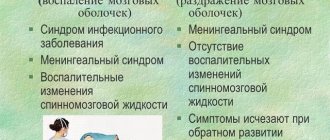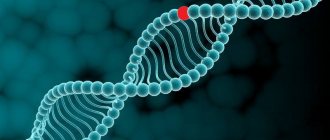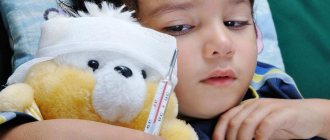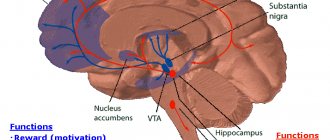Causes
Aicardi syndrome probably results from a new mutation in a gene located on the X chromosome. The exact gene or genetic mechanism that causes Aicardi syndrome is not yet known. A recently discovered report describing changes in the TEAD1 and OCEL1 genes in two girls with the syndrome was not confirmed in a large group of other girls with Aicardi syndrome. Thus, these genes do not appear to be the cause of Aicardi syndrome. The condition is believed to be fatal to newborn male children.
The parents of a woman with Aicardi syndrome are usually not affected. There have been no reports of transmission of Aicardi syndrome from the affected mother to her child. Other family members are also usually not at increased risk.
Symptoms and signs
Aicardi syndrome usually begins with involuntary muscle spasms between the ages of four months and four years.
Other symptoms may include epilepsy, mental retardation, profound muscle weakness (hypotonia), abnormally small head (microcephaly), abnormally small eyes (microphthalmia), incomplete development of the retina and nerve at the back of the eye (coloboma), and/or rib and/or abnormalities. spine.
Children of all ages with Aicardi syndrome experience significant delays in motor development. Aicardi syndrome can be life-threatening in childhood due to complications of upper respiratory tract infections.
Most girls with Aicardi syndrome have a severe delay in psychomotor development. In the neurological status, it is often noted that there is a significant decrease in the size of the skull (microcephaly), muscle hypotonia, possibly unilateral muscle hypertension and spasticity, brisk deep tendon reflexes or impaired performance of the limbs (hemi- or tetraparesis).
Agenesis of the corpus callosum in Aicardi syndrome is usually total, often accompanied by heterotopia of the cerebral cortex, cortical atrophy, structural asymmetry of the cerebral hemispheres, normal pressure hydrocephalus, polymicrogyria or pachygyria, choroidal cysts and papillomas, ventriculomegaly, intracerebral cysts, Dandy-Walker syndrome.
How does the syndrome manifest itself?
Children 2 to 5 months old who have Aicardi syndrome are outwardly indistinguishable from healthy babies. Later, convulsions or infantile spasms begin to appear. They represent a type of epileptic syndrome.
The child reduces vigorous activity and falls into a stupor. The gaze is fixed on one point. The arms begin to rise up and bend.
The body arches and the legs begin to straighten sharply. This takes seconds and can be continued at any moment. During seizures, the baby becomes irritable and cries constantly. Later, such seizures often lead to epilepsy.
In parallel, other symptoms of Aicardi syndrome are present:
- the retina is affected, yellowish spots appear in the eyes;
The photo shows an eyeball with Aicardi syndrome - the child's eyes are abnormally small;
- congenital coloboma - a notch, gap or slit in the iris of the eye;
- developmental delay;
- problems feeding the baby;
- diarrhea;
- entry of food and gastric juice into the esophagus - gastroesophageal reflux (in adults - heartburn). It often goes away on its own and is not a serious condition. However, you should know that this is one of the signs of the disease;
- muscle lethargy.
Based on observations of patients, additional signs can be identified:
- lateral location of the eyebrows, their rarity;
- protruding incisors and upturned nose;
- the angle of the nasal septum is reduced.
Sometimes growths and lumps on the skin are observed: nevi, skin diverticula and tumors, the cause of which is the pathology of blood vessels - hemangiomas. A hand anomaly is rare.
There are patients with plagiocephaly (a flattened area on the head), facial asymmetry, as well as cleft palate or upper lip. The size of the head and hands is noticeably smaller than that of a healthy person. The nose is flat and the ears are overly large. Too little space separates the nose and lips.
More patients developed severe epileptic seizures that did not go away until the end of their lives. The presence of hemivertebrae and the absence of ribs is known, leading to a noticeable curvature of the spine.
Increased risk of developing tumors:
- choroid plexus papillomas;
- lipomas;
- angisarcoma;
- hepatoblastoma;
- hemangiomas;
- angiosarcomas;
- hepatoblastoma;
- interstitial polyposis;
- embryonal calcioma;
- intestinal polyposis.
Anomalies in the eyes can lead to pigmentary renitis and microphthalmia. Cataracts and optic nerve atrophy are possible. This can lead to visual impairment and even complete blindness.
The endocrine system is often disrupted - late onset of puberty or obvious delay.
Physical development begins to slow down. At the age of 7-10 years, the patient looks like a five-year-old. Weight also increases with a delay.
According to scientists, the brain of a healthy child has more folds than that of a child with Aicardi syndrome. It happens that cysts that are filled with fluid form in the affected brain.
Most patients have a pronounced mental retardation, however, sometimes they are simply poorly able to learn.
The ability for articulate speech is often very poorly developed. Independent movement is rarely observed. Some are completely dependent on the help of other people.
Affected Populations
There are approximately 500 known cases of Aicardi syndrome worldwide, with a particularly large number in Japan. The syndrome occurs in children of different racial backgrounds.
According to recent studies in Sweden, the prevalence of Aicardi syndrome ranges from 2 to 15 cases per 100,000 girls. Unfortunately, similar studies have not been conducted in Russia. However, given the phenotypic diversity and diagnostic difficulties, many cases of the disease remain undiagnosed. This allows us to revise data on the true prevalence of Aicardi syndrome upward; perhaps Aicardi syndrome is a more common cause of mental retardation and infantile spasms in girls than is currently believed.
Today, it is believed that the incidence of Aicardi syndrome among all children with infantile spasms is only about 2-4%.
Diagnostics
To date, there is no specific laboratory diagnostic test or study that would allow a diagnosis of Aicardi syndrome. To do this you need:
- neurological examination;
- ophthalmoscopy;
- electroencephalography (EEG);
- magnetic resonance imaging with and/or without contrast;
- X-ray of the skeleton.
Magnetic resonance imaging can detect agenesis of the corpus callosum, asymmetry of the cortical hemispheres, heterotopia of the cortex, intracerebral cysts, choroid plexus papilloma, etc. Cortical axons, which normally should intersect, are not formed during its agenesis and, accordingly, are not identified during neuroimaging.
Agenesis of the corpus callosum allows the lateral ventricles to extend upward into the frontal and parietal white matter. This condition is called superior translocation of the lateral ventricles into the frontoparietal regions of the brain. The third ventricle undergoes a similar upward displacement, which is one of the neuroradiological markers of agenesis of the corpus callosum. The enlarged third ventricle, moving forward and upward, pushes the anterior horns of the lateral ventricles apart; with concomitant hydrocephalus, the volume of the ventricles increases, the posterior horns expand and bend towards the midline (the “grip” shape). It is likely that the lack of supportive function of the corpus callosum is the basis for the typical feature of agenesis of the corpus callosum - enlargement of the hemispheres, third ventricle and foramen of Monroy.
Typical changes in electroencephalography in the form of hypsarrhythmia, characteristic of infantile spasms, do not occur in all patients. The most characteristic changes in the seizure EEG consist of bursts of irregular fast and slow waves lasting from 3 to 6 seconds, which are interspersed with some flattening of the basic rhythm for 5-20 seconds, and the changes are not synchronized across the hemispheres. Electroencephalography shows the “split brain” phenomenon. Since in almost half (42%) of patients infantile spasms are combined with other types of epileptic seizures, EEG data may be contradictory.
Ophthalmoscopy reveals white or yellow-white, well-demarcated, round depigmented areas.
Pathomorphology
Scientists and doctors resort to different methods to establish Aicardi syndrome. Photos of the brain using magnetic resonance imaging are one of the most common, but it is only possible to examine the entire picture at an autopsy. During a brain examination, multiple abnormalities in the development of the neural tube can be detected:
- complete or partial absence of the corpus callosum;
- change in the position of the cerebral cortex;
- abnormal positions of the gyri;
- cysts with serous contents.
Examination under a microscope reveals abnormalities in the cellular structure of the affected areas. The fundus of the eye also exhibits characteristic changes, such as thinning of tissues, a decrease in the number of vessels and pigment, but at the same time the proliferation of cones and rods.
Treatment of Aicardi syndrome
Treatment for Aicardi syndrome has not yet been developed. Symptomatic treatment is mainly used. The main treatment strategy is the relief of infantile spasms, which are often resistant to antiepileptic drugs; their treatment is complex and its effectiveness is low. Various medications are used in the highest possible doses.
Initial therapy begins with vigabatrin (Sabril) - 50-100 mg/kg/day and valproate (Depakine syrup) - 50-100 mg/kg/day. For frequent attacks, combinations of antiepileptic drugs with benzodiazepines (clonazepam) -0.25-2 mg/day, or phenobarbital (5-15 mg/kg/day) are prescribed, and suxilep 15-30 mg/kg/day can also be administered.
An alternative method is the use of corticosteroid hormones (ACTH, synacthen-depot IM, dexamethase, prednisolone) and octagam. The average dosage of prednisolone is 1-2.5 mg/kg/day, followed by a transition to the minimum maintenance dose. Hormones are prescribed in combination with basic antiepileptic drugs.
Vagus nerve stimulation can be used as a palliative surgical treatment. Since musculoskeletal defects can lead to scoliosis, physiotherapy and exercise therapy are used to prevent it, and surgical correction is possible.
Forecast
The prognosis for girls with Aicardi syndrome varies depending on the severity of their symptoms.
The prognosis for Aicardi syndrome is usually serious due to severe mental retardation and the resistant nature of seizures. Some children (up to 25%) die in the first years of life. Of the surviving children, only 25% walk independently and only 50% have self-care skills.
Life expectancy is highly variable, depending on the severity of symptoms. The average life expectancy, according to various sources, ranges from 8.3 to 18.5 years. But there is information about a 32-year-old woman with Aicardi syndrome, as well as a 49-year-old woman with a moderate form of the syndrome
Story
In the 60s of the twentieth century, French neuropathologist Jean Aicardi described a dozen cases of this pathology. There are earlier mentions of them in the medical literature, but then they were classified as manifestations of congenital infection. Seven years after the first publication, the medical community introduced a new nosological unit - Aicardi syndrome.
But research into the disease continued, the number of symptoms expanded, and even new branches appeared. For example, Aicardi-Gauther syndrome, which manifests itself as encephalopathy with calcification of the basal ganglia and leukodystrophy.









